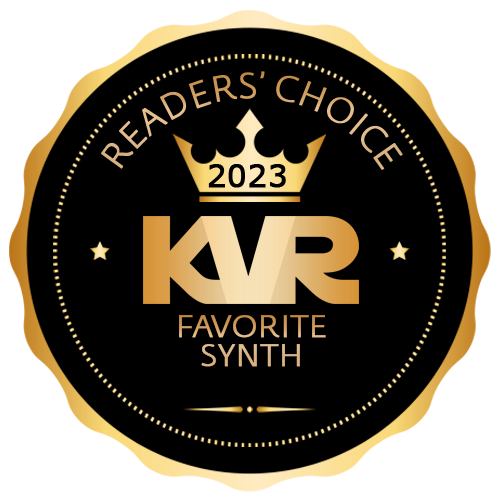Polyphonic Legend
Memorymode is based upon one of the very best-sounding polyphonic programmable analog synthesizers of the 80s - the legendary Memorymoog synthesizer. Released in 1982, the Memorymoog raised the sonic bar with its lush, powerful analog sound. Memorymode was expertly modeled upon a vintage Memorymoog originally owned by jazz legend Chick Corea. It expands upon the original without compromising any of the sound or functionality that made it great, and does away with the reliability, maintenance, and tuning issues of the original. The user interface has been streamlined and simplified, updating the original instrument's numeric-keypad-and-command-numbers with fast, simple-to-use pop-up menus and an improved value display window.
Memorymode replicates the incredible sound and feel of the original instrument at a tiny fraction of the cost of a vintage original, delivering all the power and musicality of the Memorymoog at a price anyone can afford.
Memorymode delivers a one-two punch of huge tonality, with super-accurate replications of the original three-oscillator voice architecture and a precise implementation of the coveted ladder filter circuit. Further contributing to its famous hefty sound, Memorymode's oscillator mixer gently overdrives when levels are cranked, just like the original.
In addition to all of the voicing and modulation that made the original sound so great, we've added a number of creative and convenient features aimed at modern music makers. Memorymode's LFO, arpeggio, and delay effects all feature one-button tempo sync, and filter and amplitude velocity sensitivity add a whole new layer of expressiveness. A unique Drift parameter allows continuously-variable adjustment of tuning accuracy, from perfectly in tune, to aged and loose, or anywhere in between, and the Modern button brings Memorymode into the present with fattened bass and sparkling highs. Comprehensive MPE support is included for expressive controller performances, and Memorymode's high-quality effects add the final polish to patches, including an earthy stereo phaser, a dreamy stereo ensemble, a flexible tempo-synced echo, and a lush reverb section.
Includes 600+ presets from all-star sound designers. For those not inclined to program their own sounds, Memorymode includes over 600 stunning presets, including all 100 original factory presets, created by a veritable dream team of industry-veteran synth programmers, and showcasing Memorymode's immensely flexible voice architecture.
Memorymode Features:
Memorymode is available in AU, VST, VST3, AAX, and standalone formats.
A free 30-day demo of Memorymode is available. This demo will play white noise periodically, but is otherwise unlimited.
{See video at top of page}
Reviewed By Stoffel11 [all]
February 11th, 2023
Version reviewed: 1.4.0 on Mac
Superb simulation of the original device, but:
The copy protection system wants to register the plugin and load some stuff online from time to time.
At homestudio that's ok, but on stage you mostly have no internet and therefore it's a very high risk to use this plugin there. I had several connections to the support, got some solutions but have still this annoying behavior. So only two and not five stars.
Read ReviewReviewed By kevingriffin [all]
May 10th, 2022
Version reviewed: 1.2.0 on Windows
Dear Potential Buyer,
I think that the Cherry Audio Memory-mode has exceptional sounds and exemplary tone for any style of music. I think that this synth will give music a vibrance and harmony to give it life.
Sincerely,
Kevin.
Read ReviewReviewed By MarulaMusic [all]
July 27th, 2021
Version reviewed: 1 on Windows
Another great release from Cherry Audio. I have all of their previous stand alone synths and this is my favorite by a long shot. It's far more flexible than the Juno and yet still super simple and fun to program without having to get into patching things manually like the ARP and MS20 models they've done. I've always been surprised that the Memory Moog hasn't been modeled in software more seeing as it's counterparts, all the legendary poly synths from the early eighties such as the Jupiter 8, Sequential Prophet 5 and Oberheim OBXa, have had numerous iterations released in software form from various developers over the years.
They've added some additions not available in the original hardware which are much appreciated in the form of additional fx. The GUI is clean and intuitive, it's fairly lightweight in the resources department and it sounds fantastic. This feels very much like U-He's Repro to me (the design of the Moog and Prophet are not far off, though the Moog does have the extra oscillator available), which is big compliment from me seeing as it is one of my favorite VST's of all time. I'm not sure it's quite as polished in certain respects like the FX, but like with most of Cherry Audio's synths, at $49, Memorymode is an absolute steal. I'd highly recommend picking this up.
Read ReviewReviewed By Chipi [all]
July 27th, 2021
Version reviewed: 1.0.2 on Windows
The MEMORYMOOG from 1982 was the first polyphonic and storable synthesizer from MOOG MUSIC. Although the POLYMOOG, which had already been published in 1975, had polyphony, it used an octave divider circuit and all voices had to be content with a single filter. In addition, he had no memory slots for his own sound creations. The MEMORYMOOG, on the other hand, had six independent voices, each with its own oscillator trio, filters, envelopes, VCA, etc. And the sounds created with it could be saved and called up again.
At the time, the MEMORYMODE was often regarded as a six-fold MINIMOOG, this may be true to a certain extent, but the matter is not completely true, despite some existing similarities (three oscillators, cascade filter circuitry), there are also a few differences in the sound architecture. For example, the oscillator circuit was realized using the CURTIS CEM3340 chips, which are also used by the competition, while the MINIMOOG still had a discrete design. The MEMORYMOOG also had a separate LFO and the possibility of oscillator synchronization. Two complete ADSR versions are used as envelopes, which are also based on CURTIS chips.
As always, the synth is only available for 64-bit systems, with WINDOWS it must be at least version 7 and with macOS it starts from version 10.9. A standalone version that does not require a host is available as well as plugins in the formats VST2, VST3, AAX and AU. In my test, I only limited myself to the VST variants under WINDOWS 7 and 10, because there is neither an apple computer around here, nor do I use the AAX plugins intended only for PRO TOOLS. My setup consists of a stationary studio computer (CPU i7-4790K with 4 x 4.0 GHz, 16 MB RAM) with WINDOWS 7 and a laptop (CPU i5-4200m with 2 x 2.50 GHz, 4 GB RAM) with WINDOWS 10. On both computers, the MEMORYMODE ran smoothly even with several instances at the same time, without making the respective system sweat.
Let's now turn to the sound architecture of memoryMODE and start with the centrally positioned oscillator department. As with the model, we find here three oscillators, each of which can generate the waveforms pulse (with manually adjustable and modulable pulse width), ascending sawtooth and triangle. The foot position can be 16', 8', 4' or 2'. Oscillators 2 and 3 can be detuned to oscillator 1, the second oscillator can also be synchronized to the first. The third oscillator, on the other hand, can – as was once the case with the MINIMOOG – be moved to the sub-audio range and decoupled from the pitch control by the keyboard in order to use it for modulation purposes.
To the right of the oscillators is the mixer section. Each of the three oscillators can be adjusted separately in its volume, in addition, a white noise can be infinitely add.
This signal mixture then passes first through the filter and then the amplifier. The filter is a replica of the famous MOOG transistor cascade (what else...). In contrast to the original, the slope can be switched between 12 dB and 24 dB per octave. Adjustable parameters include the cut-off frequency(CUTOFF), the resonance (EMPHASIS, extends to self-oscillation), the depth of modulation of the envelope (CONTOURED AMOUNT) and the influence of the played pitch (KB TRACK).
Filter and amplifier envelopes correspond to the classic ADSR variant, the influence of the velocity can be defined in both by virtual rotary knob. For the two envelopes together, there are four switches with the functions RETURN TO ZERO (in the case of notes struck directly one after the other, the attack phase of the last played note is reset to the beginning), UNCONDITIONAL CONTOUR (this is not a hair care product, but causes the envelope to jump to the release phase immediately after the attack phase, even with held notes, which corresponds to an AR envelope), KEYBOARD FOLLOW (the higher the played note, the shorter the course of the attack, decay and release phases) and RELEASE (deactivates the release phase completely, thus obtaining an envelope in the style of the MINIMOOG).
No, I have never fumbled, let alone owned, a real MEMORYMOOG. However, the typical MOOG sound is still generally quite familiar to me, be it through recordings in which it was used, be it through other emulations and above all through hardware devices that I had either borrowed earlier (MOOG PRODIGY) or owned myself (BEHRINGER MODEL D).
The MOOG character is undoubtedly present in the MEMORYMODE (it should be if possible...), massive basses, fat winds and creamy leads are no problem at all. In addition, all kinds of sounds beyond the usual MOOG stereotypes are possible with the MEMORYMODE, such as soft pads, wiry sounds and oblique effects.
Although the basic sound is very convincing overall, I still have to get rid of a small criticism at this point: In the very high keyboard positions, I was able to perceive slight artifacts in some sounds, a kind of metallic-sounding coloring with a cyclic chirping. The phenomenon occurred with all waveforms, but with the pulse wave this was the most intense, and the more oscillators were switched on, the stronger it was audible. I guess this has its cause in an aliasing of the oscillators (?). With the other plugins of CHERRY AUDIO I had not noticed this so far, but I had not particularly focused my ear notice on these.
For all this, however, the MEMORYMODE can do absolutely all. And after I had approached it further in the course of the review, I had to realize that I like the part quite well. It is very fast and easy to use, more flexible in sound than it may seem at first glance, and the basic sound is also right on the whole (with only minor compromises in the very highest, usually hardly used keyboard layers).
CHERRY AUDIO offers the MEMORYMODE on its own website, but it is also available through various online shops. The introductory price this time is 39, - US dollars (currently about 33, - Euro), which is a tenth above the past introductory offers, but is still to be regarded as cheap. The regular selling price should be 59, - US dollars (so around 50, - Euro) (will it ever come...?). If you do not want to buy the cat in a poke, you should make use of the offered demo version, the 30 days should probably be enough to form your own opinion.
Read Review Hive 2
Hive 2 Pigments 5
Pigments 5 MSoundFactory
MSoundFactory ACE (Any Cable Everywhere)
ACE (Any Cable Everywhere)
Please log in to join the discussion
Submit: News, Plugins, Hosts & Apps | Advertise @ KVR | Developer Account | About KVR / Contact Us | Privacy Statement
© KVR Audio, Inc. 2000-2024